Biography
Interests
Lungisani Mkandla, Eberhard Tapera, M.* & Morris Banda
National University of Science and Technology, Department of Sports Science and Coaching, Bulawayo, Zimbabwe
*Correspondence to: Dr. Eberhard Tapera, M., National University of Science and Technology, Department of Sports Science and Coaching, Bulawayo, Zimbabwe.
Copyright © 2019 Dr. Eberhard Tapera, M., et al. This is an open access article distributed under the Creative Commons Attribution License, which permits unrestricted use, distribution, and reproduction in any medium, provided the original work is properly cited.
Abstract
The purpose of this study was to compare selected physiological characteristics of male league Zimbabwe soccer players with their regional and international counterparts. Twenty-two (22) players aged 21-33 years, who volunteered to participate in the study were categorized into three playing positions, defenders (n=7), midfielders (n=7) and forwards (n=7). Flexibility, vertical leg power, muscular endurance, agility, speed and maximal oxygen uptake (VO2max) was measured for each player. Descriptive statistics (mean and standard deviation) were used to present the physiological data for each of the three positions. A One-way analysis of variance (ANOVA) was performed on the data (at p=0.05) to determine any significant differences in the selected physiological variables in the three playing positions across four countries. Zimbabwean defenders were compared with forwards, while Zimbabwean midfielders were compared with other defenders, and Zimbabwean forwards were compared with defenders from South Africa, Croatia and North America. A Newman-Keuls post-hoc was also performed, also at p=0.05, to locate the playing countries across which any significant differences existed in each physiological variable. The study found that Zimbabwean defenders have lower flexibility than South African forwards, and higher flexibility than North American forwards, lower vertical leg power than South African forwards, comparable vertical leg power to Croatian forwards, higher vertical leg power than North American forwards, comparable muscular endurance to South African forwards, lower agility than South African, and North American forwards, higher speed than South African, and Croatian forwards and, lower VO2 Max than South African, and Croatian forwards. The study also found Zimbabwean midfielders to have lower flexibility than South African midfielders, higher flexibility than North American midfielders, lower vertical leg power than South African midfielders, comparable vertical leg power to Croatian midfielders, higher leg power than North American midfielders, lower agility than South African, and North American midfielders, higher speed than South African, and Croatian midfielders and, lower VO2 Max than South African, and Croatian midfielders. The same study further found Zimbabwean forwards to have lower flexibility than South African defenders, higher flexibility than North American defenders, lower vertical leg power than South African defenders, higher leg power than that of both Croatian, and North American defenders, similar muscular endurance values to South African defender, similar speed values to both South African, and Croatian defenders and, lower VO2 Max than both South African, and Croatian defenders. It is recommended that Zimbabwean players (defenders, midfielders and forwards) improve their flexibility, vertical leg power agility and in order to compete more favourably with their regional, and international counterparts. Future similar studies should also include goal-keepers in the soccer playing positions studied.
Introduction
Soccer, also known as football, is the most popular team sport in Zimbabwe and the world [1,2]. It is
characterized by high intensity, short term actions and pauses of varying lengths. The sport comprises of
sprints, jumps, change of direction, among other movements. It is practiced socially and professionally by
many segments of the population. Several studies have been done on physiological profiles of elite soccer
players in the America and Europe, among other profiles (Ostojic, 2002) [3,4]. Few such studies have
however been done in Africa. Clark (2007) [5] observes that positional roles are less well distinguished on
the basis of physical fitness in Africa. Knowledge of the physiological attributes of players, among other
attributes, is of paramount importance to coaches, trainers, players, educators and physiotherapists among
countless others in order to effect sound interventions in sports. It appears logical that if the main physical
and physiological features that influence player performance in soccer can be identified, then they can be
nurtured to yield success. (Bangsbo, 1994) made the observation that soccer is not a science but observes
that science may help improve performance in soccer. Assessment of physical capacities of athletes is a
very important issue in modern sport. Numerous tests are available for selection procedures, for screening
candidates or to monitor the efficacy of (sports) training regimes [6].
There is scarce scientific literature on physiological profiles of soccer players in Zimbabwe in particular, and Africa in general.
The purpose of this study was to evaluate selected physiological characteristics of male soccer league players
in Zimbabwe, using Bulawayo Chiefs Football Club as a case study. The research sought first, to determine
the physiological characteristics flexibility, vertical leg power, speed, muscular endurance, agility, speed and
maximal oxygen uptake (VO2max) of Zimbabwean soccer players, and second, to compare the variables by
playing positions (PPs) defenders, midfielders and defenders with soccer players from South Africa, Croatia
and North America.
The study hypothesized that there will be significant differences in flexibility, vertical leg power, speed,
muscular endurance, lower body, agility, speed and maximal oxygen uptake (VO2max) of male league
Zimbabwean soccer players across the countries.
It is assumed in this study that all other factors, including anthropometry, technique, tactics and psychology
are constant across the countries being investigated.
Results of the study are expected to
a) provide information for the coaches to better plan and improve the training program and help the players
to enhance their performance.
b) help in the screening and selection of soccer players for specific positions in soccer
c) assigning of relevant tasks that match their anthropometric and physiological characteristics
d) provide baseline data upon which future related studies can refer to, and,
e) provide data that will enhance the formulation of sound training strategies that will improve sports
performance.
f) predict the competitiveness of Zimbabwean soccer players against their regional and international
counterparts from a physiological perspective.
Bulawayo Chiefs Football Club was involved in the competitive Premier Soccer League during the time of
the study. It was consequently difficult to test them physiologically as many times as the researchers would
have wanted. The small sample size, n=22, was another limiting factor. Consequently there was only one
goalkeeper available in the limited sample which made comparison of that PP impossible.
The study was delimited to one team, Bulawayo Chiefs Football Club and male soccer players who were
involved in the First Division soccer during the research. The study was further restricted to the physiological
measures speed, vertical leg power, agility, muscular endurance, flexibility, and VO2max, the PPs defenders
midfielders and forwards, and the countries Zimbabwe, South Africa, Croatia and North America.
Literature Review
This chapter contains a review of literature related to the topic under study.
Soccer is the most popular sport in the world. It is played by males and females of different ages, race or
ethnicity at varying levels of expertise [11]. There is limited scientific information pertaining to physiological
sports performance parameters in Zimbabwe. Playing football requires specific physiological characteristics,
besides skill, experience and intelligence, and other characteristics [12,13]. Soccer is an invasive team sport
lasting a minimum of 90 minutes and characterized by intermittent regimens of effort [14].
A physiological profile of a team will identify the general readiness of the team for competition, and the
specific preparedness of a team to face other teams of known physiological profiles. Such profiles can change with factors such as methods of exercises, volume of tournament, stage and course of the season and other
similar cases [14].
Flexibility refers to the range of motion at a single joint or series of joints, and refers to the ability of the
muscle tendon to stretch within the physical constraints of that joint [15]. Glem and McHugh (1997)
[16] defined it as the amount of movement of a joint through its normal plane of motion. Flexibility is an
important component of sports performance, and is important for injury prevention and rehabilitation.
Poor flexibility will increase the risk of injury, reduce the range of motion, impair skilled movement, prolong recovery, and reduce speed and agility [15,17]. Ekblom (2005) found that stretching after a training session could increase flexibility on the next day. Chin et al., (1992) [18] weighs in, stating that poor flexibility indicates tight hamstrings which may be due to the design of soccer training and the need for specific training to increase the range of motion in order to reduce the incidence of soccer injuries.
Leg power is the ability to release maximum muscular force in an explosive manner in the shortest duration.
It is a very important component sports such as football and basketball [19]. All movements depend on the
muscular power of the legs [20] which apparently shows that dynamic actions such as sprinting, jumping,
kicking and heading rely on leg power for successful performance. Grey and Jenkins (2010) [21] stated that
bumping, tackling and tussling activities that take place when contesting and marking the ball in soccer
require higher levels of lower limb and upper limb body power. In addition, Wilsoff et al., 2004 points out
that given the importance placed on explosive power in the modern game, it has been suggested that elite
senior soccer players are expected to have a vertical jump value close to 60cm. Ostojic (2000) agrees with the
foregoing statement, adding that vertical jump tests results are related to positional role, phase of training
and level of play, with elite soccer players performing significantly higher jumps of 47.6±5.7cm, compared
to non-elite players who recorded jumps of 46.2±5.5cm. Wilsoff et al., (2004) tested top-level professional
players competing in the UEFA Champions League and found mean vertical jump heights between 50cm
and 60cm. Positional differences in vertical jump height have been noted by numerous authors, with the
goalkeepers having the highest scores whilst midfielders were found to jump lower than the other outfield
players (Reilly and Thomas, 1979).
It is the ability of a muscle or muscle group to make repeated contractions against a resistance without tiring.
In soccer muscular endurance enhances performance and reduces injury risks. (Bangsbo, 1994) argues that
maintaining work intensity throughout a soccer match is a function of muscular endurance. The same author
weighs in further, indicating that muscular endurance in soccer is important in dominating possession and
enforcing team tactics while maintaining technical competence.
Agility is the physical ability which enables an individual to rapidly change the body position and direction
in precise manner [22]. It is the speed with which an individual may change his body positions or fastness
in changing direction while moving. Agility is a key physiological variable in team sports as it can become
vital in performing key tasks such as defending and beating an opponent [23]. The dynamic nature of soccer
requires agility.
The ability to turn quickly, and the fact that soccer players should be able to run well dodging and performing spiral motions without losing balance and decelerate in order to pass the opponent underlines the importance of agility in soccer [14].
Sheppard et al., (2006) also states that anticipating the direction and timing of the ball are crucial issues for success in soccer. Soccer is characterized by abrupt directional and speed changes. A soccer player who is agile is able to maneuver with enhanced balance and coordination is thus an asset in the team.
Running patterns of team sport athletes are characterized by rapid changes in direction, as compared to linear running in track and field athletes (Dawson et al, 2004; Young et al, 2002) [24].
It has been shown that elite first division soccer players have approximately 1000 changes in playing activities during a game, often involving high agile movements (Reilly and Thomas, 1976; Bangsbo, 1994). Thus, the ability to produce fast-paced variable actions can impact soccer performance, making the assessment a soccer player’s agility imperative [25].
Stolen et al., (2005) [4] notes that speed is an important component in soccer. This physiological variable
influences the ability to accelerate, a phenomenon often deciding important outcomes in a soccer game. In
addition [26] admits that soccer players have to accelerate quickly over short distances to meet the technical,
tactical and physical demands of the game.
Sprint tests have been shown to discriminate between different levels of players, with professional players being found to be faster than amateur players over short distances of 10m, 20m and 30m [27].
Successful soccer teams have players who can operate at high speed, under intense pressure and in smaller spaces given the higher work-rate of the players who close on the player with the ball faster than before says Tipping (2009) [28].
In elite football, forwards are the fastest players, and time observations show that they sprint the most during a match [1]. In a study on Belgian elite soccer players, Boone et al., (2011) [29] showed that attackers had more speed than midfielders, fullback, sweeper and goalkeepers. No differences in acceleration were found over 10m in different playing levels and positions in English Premier League footballers (Power et al., 2004).
Furthermore, Wisloff et al., (2004) reports that mean and standard deviation for sprints tests of 10m, 20m and 30m of Rosenberg’s team players was equal to 1.82±0.3 seconds, 3±0.3seconds and 4±0.2 seconds), respectively. The same study shows that there was no significant difference in related values according to the positions of the players.
VO2max is the ability of the heart and lungs to take in and to transport adequate amount of oxygen to the
working muscles for the activities that involve large muscles for long periods of time. The aerobic system is
the main source of energy provision during soccer match play and the average values of VO2 max for top level
soccer players tend to be high, argue Tumility, (1993) [30] and Reilly et al., (2000) [31]. Aerobic performance
represented by VO2Max is regarded as an important physiological parameter for optimal performance [32].
The relevance of aerobic training to soccer has been confirmed by studies [33,34], showing a relationship
between aerobic power and competitive ranking, quality of play and distance covered during the match.
Players in different team positions have a different workloads during a game, with midfielders running the longest distances of up to 11.5km, followed by forwards and defenders (Bangsbo et al, 1991). Stolen et al (2005) [4], concur with that, stating that the highest oxygen consumption values in soccer have been found in midfielders, and the lowest values in goalkeepers.
Therefore soccer players should be selected considering the specific demands of each and every playing position. Reilly et al., (1996) [14] found the average VO2Max for top level soccer players to range from 55- 70ml/kg/min. Ostojic (2000) concurs with that statement, further observing that VO2 max may be influenced by differences in standard of play, training regimens and stage of the season.
Research Methodology
This chapter describes the research design, population, sampling method, sample size and the data collection
protocols used for the study.
The study used a quantitative descriptive cross-sectional research design. The researcher measured the
physiological variables under investigation once during the 2017-2018 soccer season. The design selected is
shorter compared to other designs like case studies, longitudinal designs or ethnographic designs.
The population available to the research team included all the teams in the 2017-2018 Zimbabwe Premier
Soccer League. Purposive sampling was used to select a sample of 22 players from Bulawayo Chiefs Football
Club players aged 21-33 years who voluntarily agreed to participate in this study. The subjects were fully
informed of the procedures, potential risks and the benefits of participating in the study, after which they consented to take part in the research by signing consent forms. The subjects were then familiarized with the
testing procedures one week before the collection of data.
The researcher used lecturers and fourth year students from the National University of Science and
Technology Department of Sports Science as research assistants to collect data on the physiological variables
under investigation.
The researchers sought permission from the club authorities, the players and the National University of
Science and Technology. All the subjects gave their informed consent prior to the commencement of the
study. Participants’ data were stored in coded form in a private office with restricted access. Acknowledgements
were made upon completion of the research, to appreciate all the contributions rendered for the completion
of the study.
Quantitative data were collected on the physiological characteristics flexibility, vertical leg power, agility,
muscular endurance, speed, and maximal oxygen uptake (VO2max).
One reason for testing in soccer is to assign positions to players and to rank players and teams. All coaches
want to be sure they are putting their best athletes, at their best positions, in any game [35]. Testing provides
a way of establishing the potential of an athlete and the basis for performance evaluation.
All the participants performed a 10-minute warm up, which included jogging, sprinting, multi-directional movements and stretching. The players were exempted from strenuous exercise 24 hours before testing to minimize the possible effects of fatigue. All the participants were assessed on two separate days, at the same time of the day. The tests were done in the same order, with 10 minutes rest between successive tests.
Field tests (from Topendsports) were used instead of laboratory tests. Field tests are relatively are easy to administer, require no sophisticated equipment and experts, and have higher ecological validity over laboratory tests. Svensson and Drust (2005) [26] advise sports scientists to use field tests in order to evaluate specific aspects of soccer performance and to get a better indication of their ability to perform in a soccer match than laboratory based assessments. MacDougall et al., (1991) [17] state that one limitation of physiological laboratory testing is that it is not possible to simulate the physiological demands of the sport. Its practical value is therefore limited.
The test battery included the sit and reach (for flexibility), the vertical jump (for vertical leg power), the
Illinois Agility Run Test (for agility), the 1-minute sit-up test (for lower body muscular endurance), the 10m and 30m sprints (for speed) and the Yo-yo level 1 intermittent recovery test (for VO2 max).
Reliability of measurement refers to the degree to which the test yield the same result when given on two
[or more] different occasions or by the different examiners to the same group of individuals [36]. Reliability
can alternatively be defined as the consistency of an individual’s performance on a test [37].
Validity on the other hand, constitutes the degree to which an instrument measures what it is purported to
measure and the extent to which it fulfills its purpose [36].
The reliability and validity of the results was assured as the researcher first, used an approved battery of field based tests which has been used by other researchers, and second, used standard and well calibrated instruments of measurement.
The data obtained were analyzed using descriptive and comparative statistics computed using Statistical
Package for Social Sciences (SPSS Version 20.0). The results were expressed as mean and standard deviation
for each variable. Differences in physiological variables across playing position (defender, midfielder, forward)
and country were determined by using One Way Analysis of variance (ANOVA), at the p=0.05 level of
significance. A Neumann-Keuls post-hoc was conducted (at p=0.05) to locate the countries across which
any differences in physiological variables lay.
Data Presentation, Analysis and Interpretation
This chapter summarizes, analyses and discusses the data obtained from the study. It first presents tables of
values of flexibility, vertical leg power, muscular endurance, agility, speed and VO2 Max and the relevant One-
Way ANOVA results. It then summarises the results for each physiological variable and latter discusses the
results.
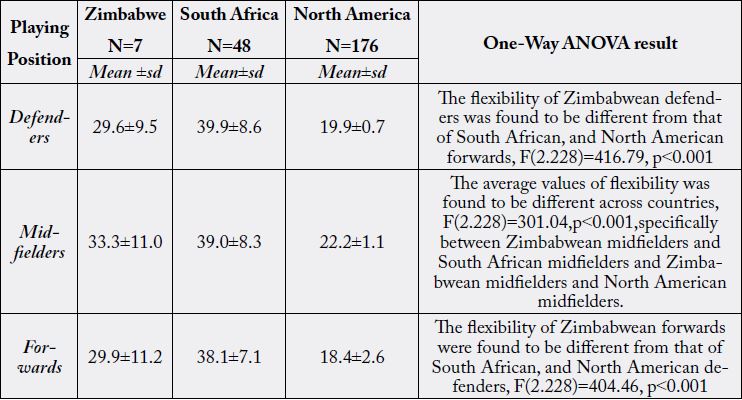
The study found that Zimbabwean defenders have lower flexibility than South African forwards, and, higher
flexibility than North American forwards.
The study found Zimbabwean midfielders to have lower flexibility than South African midfielders, but
higher flexibility than North American midfielders.
Zimbabwean forwards were found to have, lower flexibility than South African defenders, but higher
flexibility than North American defenders.
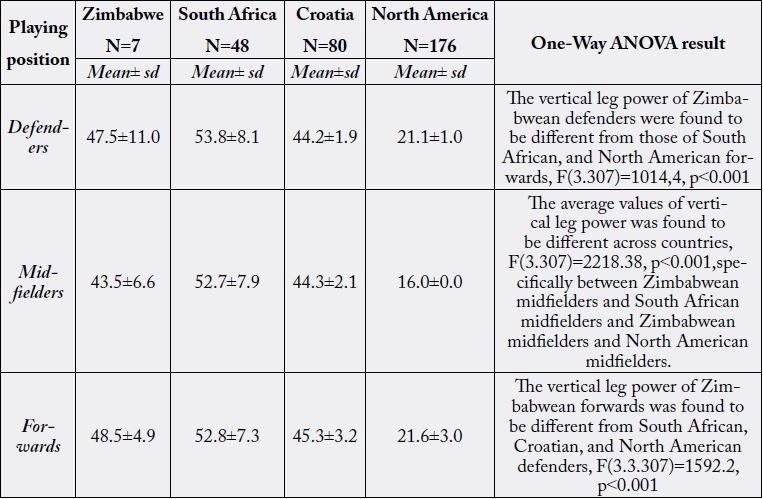
The study found the vertical leg power of Zimbabwean defenders to be lower than that of South African
forwards, comparable to that of Croatian forwards, but higher than that of North American forwards.
The study found the vertical leg power of Zimbabwean midfielders to be lower than South African midfielders,
comparable to Croatian midfielders, yet higher than North American midfielders
The study found the vertical leg power of Zimbabwean forwards to be lower than that of South African
defenders, but to be higher than that of both Croatian, and North American defenders.
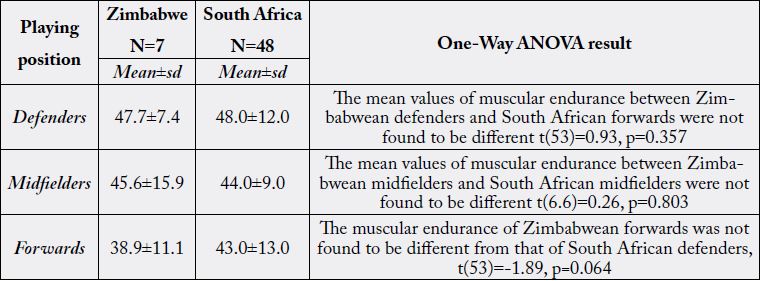
The study found that the muscular endurance values of Zimbabwean defenders were similar to those of
South African forwards.
The study found that the muscular endurance values of Zimbabwean midfielders were similar to those of
South African midfielders.
The study found that the muscular endurance values of Zimbabwean forwards were similar to those of
South African defenders.
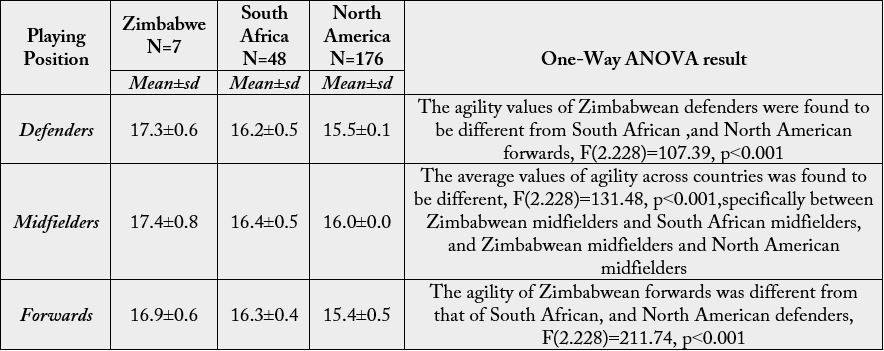
The study found the agility of Zimbabwean defenders to be lower than that of South African, and North
American forwards.
The study found the agility of Zimbabwean midfielders to be lower than that of South African, and North
American midfielders.
The study found the agility of Zimbabwean forwards to be lower than that of South African, and North
American defenders.
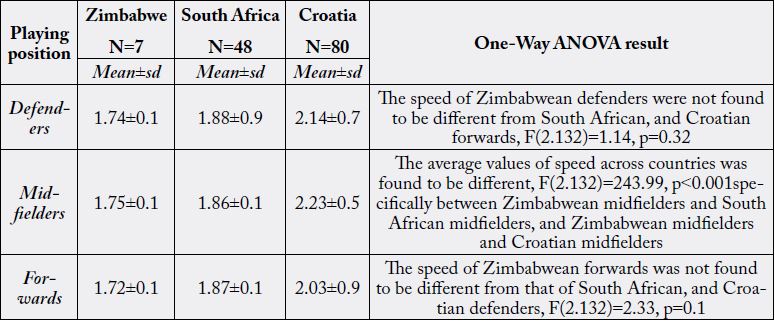
The speed of Zimbabwean defenders was found to be higher than that of South African, and Croatian
forwards.
The speed of Zimbabwean midfielders was found to be higher than that of South African, and Croatian
midfielders.
The speed of Zimbabwean forwards was found to be similar to that of South African, and Croatian defenders.
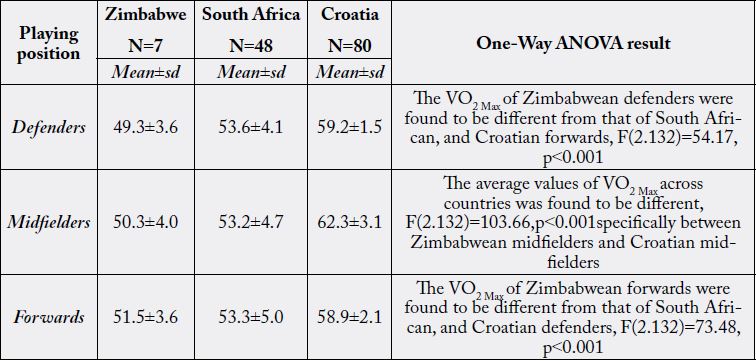
The study found the VO2 Max of Zimbabwean defenders to be lower than that of South African, and Croatian
forwards.
The study found the VO2 Max of Zimbabwean midfielders to be lower than that of South African, and
Croatian midfielders.
The study found the VO2 Max of Zimbabwean forwards to be lower than that of South African, and Croatian
defenders.
The study found Zimbabwean defenders to have:
i) lower flexibility than South African forwards, and higher flexibility than North American forwards.
ii) lower vertical leg power than South African forwards, comparable vertical leg power to Croatian forwards,
but higher vertical leg power than North American forwards.
iii) comparable muscular endurance to South African forwards
iv) lower agility than South African, and North American forwards
v) higher speed than South African, and Croatian forwards.
vi) lower VO2 Max than South African, and Croatian forwards
The study also found Zimbabwean midfielders to have:
i) lower flexibility than South African midfielders, but higher flexibility than North American midfielders.
ii) lower vertical leg power than South African midfielders, comparable vertical leg power to Croatian
midfielders, higher leg power than North American midfielders
iii) lower agility than South African, and North American midfielders
iv) higher speed than South African, and Croatian midfielders
v) lower VO2 Max than South African, and Croatian midfielders.
Additionally, the study found Zimbabwean forwards to have:
i) lower flexibility than South African defenders, but higher flexibility than North American defenders.
ii) lower vertical leg power than South African defenders, but higher leg power than that of both Croatian,
and North American defenders.
iii) similar muscular endurance values to South African defenders
iv) similar speed values to South African, and Croatian defenders lower VO2 Max than South African, and
Croatian defenders.
v) lower VO2 Max than South African, and Croatian defenders.
The low flexibility of Zimbabwean defenders relative to regional and international forwards will compromise
their defensive dribbling and hence make them less competitive in that respect. The relatively lower vertical
power of Zimbabwean defenders in comparison to strikers from other countries may imply that they will
most likely be out-jumped during aerial tussles for the ball as they defend aerially. The low agility of the
defenders means that they will be most likely out-dribbled by the strikers and concede more goals as a result.
The lower VO2 Max values of Zimbabwean defenders may imply that they are prone to tire earlier than the
forwards they are assigned to mark.
The low flexibility and agility of Zimbabwean midfielders in comparison to their regional and international
counterparts means they will most likely be out-classed in dribbling to keep the ball in the middle of the
park, and in turning, to distribute the ball to strikers and other outfield players. The relatively lower vertical
leg power of Zimbabwean midfielders will imply that they will tend to lose aerial balls to the midfielders
of regional and international teams. The lower VO2 Max scores of Zimbabwean midfielders implies that they
may tire earlier than their regional and international counterparts, which could result in them being outplayed
in the midfield during later stages of the game.
The lower vertical power Zimbabwean forwards relative to their regional and international defenders imply
that the former will most likely find it difficult to head in corner kicks offensively. Also the lower VO2 Max scores of Zimbabwean forwards compared to regional and international defenders will tend to compromise
their lasting power in competition against them.
Summary, Results, Conclusions and Recommendations
The purpose of this study was to compare selected physiological parameters of male league Zimbabwe soccer
players (defenders, midfielders and forwards) across regional and international players. Quantitative data
were collected using the sit and reach (for flexibility), the vertical jump (for vertical leg power), the Illinois
Agility Run Test (for agility), the 1-minute sit-up test (for lower body muscular endurance), the 10m and
30m sprints (for speed) and the Yo-yo level 1 intermittent recovery test (for VO2 max). The data were expressed
as means and standard deviations for each playing position, for each of the countries Zimbabwe, South
Africa, Croatia and North America. A One-Way ANOVA (at the p=0.05 significance level) was performed
on the data to establish any differences in each physiological attribute across countries. A Newman-Keuls
post hoc (again at the p=0.05 significance level), was further performed to located the countries across which
any significant differences existed in the physiological variables, in the relevant playing positions.
The study found that Zimbabwean defenders have lower flexibility than South African forwards, and higher
flexibility than North American forwards, lower vertical leg power than South African forwards, comparable
vertical leg power to Croatian forwards, higher vertical leg power than North American forwards, comparable
muscular endurance to South African forwards, lower agility than South African, and North American
forwards, higher speed than South African, and Croatian forwards and, lower VO2 Max than South African,
and Croatian forwards.
The study also found Zimbabwean midfielders to have lower flexibility than South African midfielders, higher flexibility than North American midfielders, lower vertical leg power than South African midfielders, comparable vertical leg power to Croatian midfielders, higher leg power than North American midfielders, lower agility than South African, and North American midfielders, higher speed than South African, and Croatian midfielders and, lower VO2 Max than South African, and Croatian midfielders.
The same study further found Zimbabwean forwards to have lower flexibility than South African defenders, higher flexibility than North American defenders, lower vertical leg power than South African defenders, higher leg power than that of both Croatian, and North American defenders, similar muscular endurance values to South African defender, similar speed values to both South African, and Croatian defenders and, lower VO2 Max than both South African, and Croatian defenders [38-67].
The study found that Zimbabwean players (defenders, midfielders and forwards) have lower flexibility,
vertical leg power, agility and VO2 max, compared to their regional and international counterparts (forwards,
midfielders and forwards).
It is recommended that Zimbabwean players (defenders, midfielders and forwards) improve their flexibility,
vertical leg power agility and in order to compete more favourably with their regional, and international
counterparts (forwards, midfielders and defenders). Future similar studies should also include goal-keepers
in the soccer playing positions studied.
Bibliography

Hi!
We're here to answer your questions!
Send us a message via Whatsapp, and we'll reply the moment we're available!